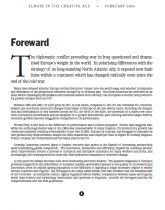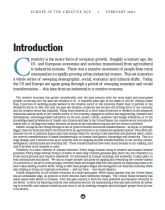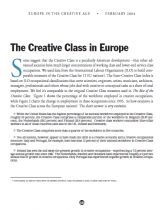Hledej
Zobraz:
Univerzity
Kategorie
Rozšířené vyhledávání
12 662
projektů
Europe in the creative age
| Přípona |
Typ projekt |
Stažené 0 x |
| Velikost 0,8 MB |
Jazyk anglický |
ID projektu 2928 |
| Poslední úprava 27.03.2014 |
Zobrazeno 1 959 x |
Autor: eliseus |
 Sdílej na Facebooku
Sdílej na Facebooku |
||
| Detaily projektu | ||
- Cena:
2 Kreditů - kvalita:
88,2% -
Stáhni
- Přidej na srovnání
- Univerzita:Univerzita Tomáše Bati ve Zlíně
- Fakulta:Fakulta managementu a ekonomiky
- Kategorie:Ekonomika » Management
- Předmět:Management
- Studijní obor:-
- Ročník:-
- Formát:PDF dokument (.pdf)
- Rozsah A4:48 stran
Creativity has become a driving force of economic growth. The ability to compete
and prosper in the global economy goes beyond trade in goods and services
and flows of capital and investment. Instead, it increasingly turns on
the ability of nations to attract, retain and develop creative people. This report
extends the concepts and indicators introduced in The Rise of the Creative Class to
the European context. It develops new indicators for the Creative Class and competitiveness
that are based on the 3Ts of economic development—Technology, Talent and Tolerance
— for 14 European, Scandinavian and Nordic countries and compares them to the
United States. While these measures differ in significant respects from the indicators in
The Rise of the Creative Class, the findings are just as illuminating and compelling.
and prosper in the global economy goes beyond trade in goods and services
and flows of capital and investment. Instead, it increasingly turns on
the ability of nations to attract, retain and develop creative people. This report
extends the concepts and indicators introduced in The Rise of the Creative Class to
the European context. It develops new indicators for the Creative Class and competitiveness
that are based on the 3Ts of economic development—Technology, Talent and Tolerance
— for 14 European, Scandinavian and Nordic countries and compares them to the
United States. While these measures differ in significant respects from the indicators in
The Rise of the Creative Class, the findings are just as illuminating and compelling.
Klíčová slova:
creativity
economic
development
age
indicators
Obsah:
- n Executive Summary 5
n Introduction 7
n The Creative Class in Europe 9
n Euro-Talent Index 11
n Euro-Technology Index 15
n Euro-Tolerance Index 21
n Euro-Creativity Index 27
n Euro-Creativity Trend Index 32
n Euro-Creativity Matrix 34
n Conclusion and Implications 36
n Appendix: Data and Methodology 38
n References 41
Zdroje:
- Florida, R. (2002a). The Rise of the Creative Class: And How Its Transforming Work, Leisure, Community and Everyday Life, New York: Basic Books.
- Florida, R. (2002b) “The Economic Geography of Talent,” Annals of the American Association of Geographers, 92, 4: 2002: 743-755.
- Florida, R. (2002c) “Bohemia and Economic Geography,” Oxford Journal of Economic Geography, 2, 2002: 55-71 Gertler, M; Florida, R.; Gates, G.; and Vinodrai, T. (2002). Competing on Creativity: Placing Ontario’s Cities in a
- North American Context, Toronto: Report Prepared for Province of Ontario, Ministry of Enterprise, opportunity and Innovation, November.
- Glaeser, E.L. (1998), “Are Cities Dying?”, Journal of Economic Perspectives. 12, 139-160.
- Gottlieb, P.D., (1994), “Amenities as an Economic Development Tool: Is There Enough Evidence?”, Economic Development Quarterly, 8 ,3, August 1994: pp. 270-285.
- Gottlieb, Paul D. (1995), “Residential Amenities, Firm Location and Economic Development”, Urban Studies, 32, 1413-1436.
- Inglehart, R, and Baker W. (2000) “Modernization, Cultural Change and the Persistence of Traditional Values,”
- American Sociological Review, February , Volume 65, pp 19-51.
- International Labour Organization (ILO), LABORSTA Labour Statistics Database, http://laborsta.ilo.org;
- International Labour Organization (ILO), Yearbook of Labour Statistics, 1999.
- Jacobs, J., (1961), The Death and Life of Great American Cities, New York: Vintage Books.
- Jacobs, J., (1969), The Economy of Cities, New York: Random House.
- Krugman, P. (1991), “Increasing Returns and Economic Geography”, Journal of Political Economy, vol. 99, 3, pp. 483-499.
- Lucas, Jr., R.E., (1998), “On the Mechanics of Economic Development”, Journal of Monetary Economics, 22: 1-42.
- Mathur, V. K., (1999), “Human Capital Based Strategy for Regional Economic Development”, Economic Development Quarterly, 13/3:203-216
- OECD Science, Technology and Industry Scoreboard 2001. Towards a Knowledge-Based Economy, 2001



